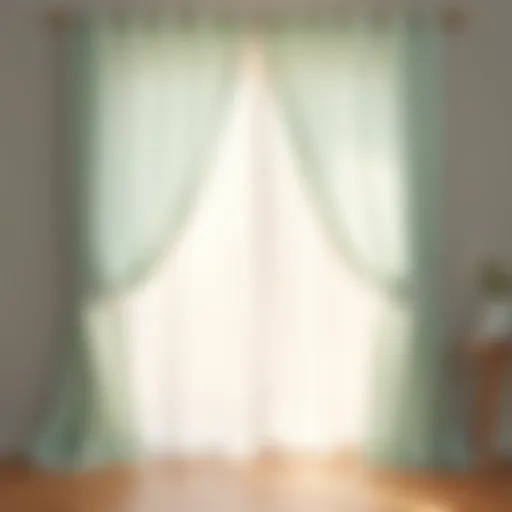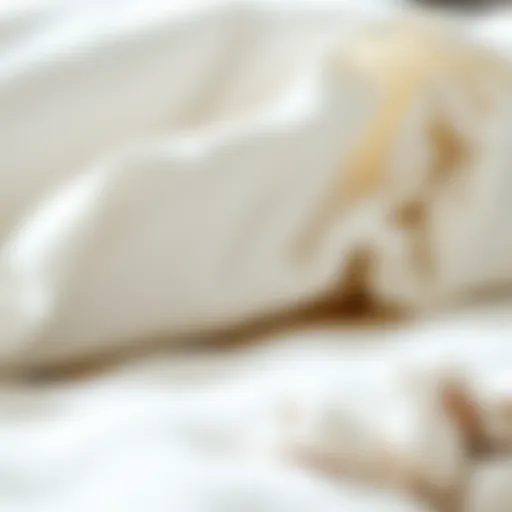Exploring Bookshelf Units: Design and Functionality
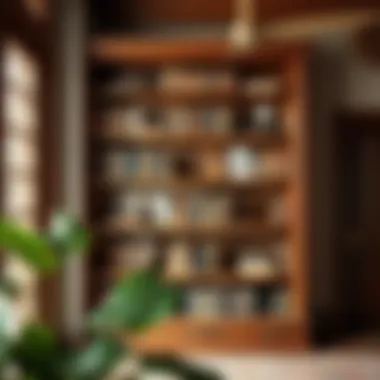
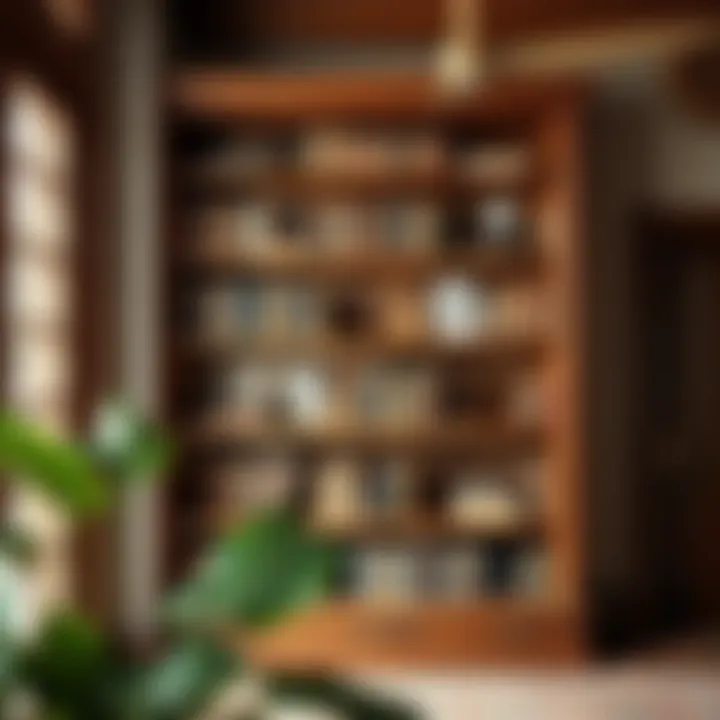
Intro
A bookshelf isn’t merely a set of wooden slats or metal frames meant to hold books; it is an embodiment of personality, creativity, and often a conversation starter. The journey of bookshelf units traces back to antiquity, serving multifaceted purposes based not just on function, but the story they tell about their owners. In today’s realm of design, the intersection of functionality and aesthetics can transform these units from simple storage solutions to architectural features that define spaces in personal homes or professional offices.
Builders, designers, and homeowners alike find themselves navigating the expansive market of bookshelf units. Each bookshelf holds the potential to reflect a homeowner’s taste, adapt to diverse decors, and serve practical needs. From classic wooden shelves laden with tomes to sleek, modern designs that highlight minimalism, the choices are endless. The modern consumer demands more than utility; they seek investment pieces that enhance their surroundings.
Moreover, understanding the nuances of bookshelf designs, materials, and contemporary trends not only elevates a space, but also enriches the reader's experience. Whether it’s transforming a dull wall into a vibrant showcase of literature or making an office feel more inviting, selecting the right bookshelf unit is essential. The following sections will guide you through current furniture design trends, essential buying tips, and recommendations based on various budgets to ensure you find the perfect unit for your needs.
Prologue to Bookshelf Units
Understanding bookshelf units is crucial for anyone looking to enhance their living or working spaces. A well-designed bookshelf not only serves its primary function of storing books but also contributes significantly to the overall aesthetic of a room. By integrating style with functionality, bookshelf units can transform any area, making it more inviting and organized. For homeowners, designers, and DIY enthusiasts, recognizing the importance of these furniture pieces helps inform choices that combine personal taste with practical needs.
Definition and Purpose
Bookshelves are more than just a collection of shelves; they are versatile units designed primarily for storing books, though their purpose has expanded over time. They can serve multiple functions from display spaces for decorative items to practical storage solutions for household essentials. The primary purpose lies in their ability to organize literature and materials, allowing for easy accessibility while minimizing clutter.
Bookshelf units can be categorized into different types based on their design and intended use. For example, freestanding bookcases are often used for larger collections, while wall-mounted shelves cater to smaller spaces. The design choices dictate how these units integrate into one's environment, giving rise to unique styles that reflect personal aesthetic preferences.
In addition to their practical benefits, bookshelf units add character. A carefully selected bookshelf can serve as a centerpiece, balancing functionality with visual appeal in living rooms or reading nooks. They can exhibit one's personality through book selection and decor items, leading to intriguing conversations. Thus, the definition and purpose extend well beyond mere storage, blending utility with personal expression.
Historical Context
Delving into the history of bookshelf units reveals an evolution influenced by cultural, technological, and aesthetic shifts. The modern bookshelf as we know it has roots that trace back to ancient civilizations. The earliest forms were largely utilitarian – wooden boxes or small shelves used to hold scrolls in ancient libraries. Each era and culture put its own spin on bookshelf design, reflecting their unique values and technological advancements.
In the medieval period, books were precious items, often stored on lecterns or large, ornate cabinets that showcased their importance. The Renaissance saw a shift, with an emphasis on aesthetics; bookshelves began to resemble handcrafted art pieces, often embellished with intricate carvings. By the time the Industrial Revolution arrived, mass production introduced a wider array of materials and designs, making bookshelves accessible to the average person.
Fast forward to today, and we see an explosion of styles influenced by minimalism, contemporary designs, and sustainable practices. Current trends suggest a return to organic materials and simplicity, resonating with today's focus on both functional and eco-friendly living. Thus, the history of bookshelf units illustrates a fascinating journey from mere containers of knowledge to integral components of home décor and functionality.
Types of Bookshelf Units
The expanse of bookshelf designs offers a wealth of options tailored to diverse needs and styles. Understanding the various types of bookshelf units can empower homeowners, designers, and DIY enthusiasts to make informed choices suited to their specific spaces and preferences. Each type embodies its own strengths, serving different functionalities and aesthetic preferences, from the elegant freestanding bookcases to the innovative modular designs. This is crucial not just for organizing books, but also for elevating the overall decor and maximizing the potential of any room.
Freestanding Bookcases
Freestanding bookcases are the champions of flexibility in the realm of furniture. These units can effortlessly blend into many styles, whether your home exudes a cozy, rustic vibe or a sleek, modern aesthetic. One of the primary benefits of freestanding bookcases is their mobility; moving them from one room to another is often a breeze, giving you the freedom to rearrange your space as you like. These bookcases come in a variety of designs, ranging from tall and slim to low and wide, ensuring that you will find something to suit both your collection and the space available.
Additionally, they provide a great canvas for personal expression. Homeowners can decorate the surface with plants, photographs, or collectibles while keeping the shelves filled with literary treasures. This dual purpose not only maximizes functionality but also adds a personal touch to the decor.
Wall-mounted Units
Wall-mounted units are a smart choice for those keen on saving floor space without compromising on style or storage. Suspended from the wall, these units provide ample room underneath for other furniture while drawing the eye upward, creating an illusion of spaciousness. They are particularly beneficial in smaller apartments or minimalist designs, allowing for a clean, uncluttered look.
Installation, however, should be approached with care. Ensuring the right fixtures and supports are employed is imperative to maintain safety and durability. The aesthetic possibilities are extensive here too; wall-mounted bookshelves can range from sleek, floating designs to more elaborate, built-in options with intricate details.
Corner Bookshelves
Every nook bears potential, and corner bookshelves stand as testament to that truth. Often underrated, these units capitalize on those neglected corners and transform them into functional and stylish storage solutions. Corner bookshelves are particularly advantageous for maximizing space in rooms that feel cramped or in need of balance.
There’s an inherent charm to corner shelves; they invite a certain coziness and can become a statement piece when thoughtfully incorporated into the room. The variety of designs—round, triangular, or angular—allows homeowners to play up architectural features while also accommodating a collection of different materials and decorative items.
Unit Systems and Modular Designs
Unit systems and modular designs offer an adaptive, contemporary approach to bookshelf organization. These systems consist of individual modules that can be configured in multiple ways, catering to the diverse needs of users. This adaptability is ideal for changing collections or spaces that demand versatility over time.
Unlike traditional designs, modular units can be easily expanded or scaled down based on your requirements. Homeowners may appreciate the unique approach to customizing their storage solutions, which can help in organizing not only books but also display items and multimedia. This type of unit encourages creativity in organization and can reflect the personality of the user, as many designs allow for unique arrangements that are both aesthetic and functional.
By exploring and understanding the various types of bookshelf units, individuals can select the one that aligns best with their practical needs and style sensibilities. Each type offers a distinctive solution to a common problem: how to display and store belongings while enhancing the fabric of the home.
Design and Aesthetic Considerations
In the world of interior design, the role of bookshelf units extends well beyond mere storage. They serve as focal points that can significantly influence the overall aesthetics of a room. The design and aesthetic considerations involve a thoughtful interplay of various elements that come together to create spaces that are not just functional, but also visually pleasing. Elements such as material choices, colors, finishes, sizes, and shapes all play vital roles in how these units blend into the environment.
Designing a bookshelf unit that stands out while fitting into a space requires careful consideration of personal style and functional needs. Each choice made during the design process can enhance or detract from the overall effectiveness of the unit. Thus, understanding these design fundamentals can help homeowners, designers, and DIY enthusiasts make informed decisions.
Material Choices
Materials form the backbone of any bookshelf unit's aesthetic appeal. Different materials provide distinct characteristics that can affect everything from the unit's durability to its stylistic impact.
Wood Options
When it comes to wood options, the warmth and natural beauty of wood remain unmatched. Woods such as oak, maple, or walnut not only provide sturdiness but also add a touch of coziness to the space. A notable characteristic of wood is its versatility; it can be stained or painted to match existing decor, allowing for utmost customization. One unique feature of wood is the potential for natural grain patterns, which can create visual interest and a sense of individuality in each piece. However, wood can be sensitive to humidity and temperature changes, which might lead to warping over time if not cared for properly.
Metal Finishes
Metal finishes present a more modern and sleek approach to bookshelf design. Materials like steel or aluminum add a contemporary flair and are ideally suited for minimalist styles. The key characteristic of metal is its durability; a well-crafted metal bookshelf can withstand the test of time and daily wear. A unique advantage of metal shelves is their lightweight nature while still offering considerable strength. Yet, the coldness of metal can sometimes be off-putting for those seeking a warmer, more inviting atmosphere in their home.
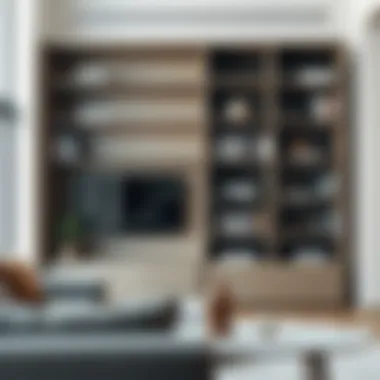
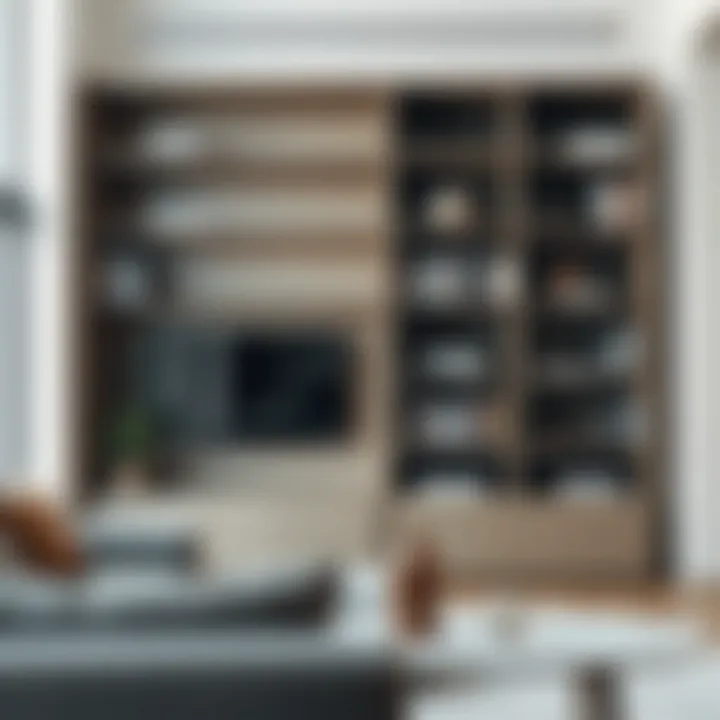
Glass Elements
Glass elements incorporate transparency and lightness into bookshelf units, making them an excellent choice for visually expanding smaller spaces. One of the defining features of glass is its ability to highlight the decorative items on display while letting light filter through. This capability makes glass a popular option in modern designs. However, glass shelves require consistent cleaning to maintain their clarity, and they may not be ideal for storing heavier items due to potential fragility.
Color and Finish
Color and finish are equally important aspects that contribute to the visual appeal and character of bookshelf units. The right color can evoke specific moods and shape the overall aesthetics of a room.
Neutral Palettes
Neutral palettes emphasize subtlety and elegance, making them a favored choice in diverse styles. Shades like beige, gray, or white create a calming effect, allowing other decor elements to take center stage. A notable benefit of neutral tones is their versatility, fitting seamlessly into various interior themes. However, a drawback could be their potential to feel dull or uninviting in overly monochromatic environments.
Bold Accents
Bold accents, on the other hand, command attention and can transform an ordinary bookshelf into a statement piece. Bright colors or striking patterns can inject energy and personality into a room. The characteristic of bold accents is their ability to act as a focal point, bringing vibrancy into the space. Yet, one must tread carefully; overly loud colors might clash with existing decor and overwhelm the overall design.
Textured Finishes
Textured finishes can add depth and intrigue to bookshelf units, elevating the design beyond flat surfaces. Options such as distressed wood, matte metals, or embossed glass contribute unique tactile experiences. The advantage of textured finishes is their ability to break monotony and create a sense of authenticity. However, one should consider that intricate textures may attract dust and require more cleaning effort.
Size and Scale
The size and scale of a bookshelf unit are critical in determining its functionality and the way it interacts with the surrounding space.
Small Space Solutions
For those confined to smaller areas, clever design solutions are imperative. Compact bookshelf units, such as ladder-style or portable shelves, minimize footprint while maximizing vertical usage. Their key characteristic is the ability to fit into nooks and crannies, transforming wasted space into usable storage and display areas. The downside could be limited storage capacity, requiring careful selection of items to be displayed.
Large Unit Options
Conversely, large unit options can dominate a room, making them suitable for spacious areas where they can flourish. Characteristics such as multiple tiers or built-in cabinets offer ample storage and display opportunities. Their unique feature is the ability to create an impactful presence, anchoring the room's layout. However, they might overwhelm smaller spaces, making it crucial to factor proportion into design.
Adjustable Heights
Adjustable heights in bookshelf units add both practicality and aesthetics. This feature allows customization based on users' changing needs or preferences. The adaptability makes them a beneficial choice for multi-purpose areas, providing storage for a growing collection of books or decorative items. On the other hand, some designs may have complex mechanisms that could cause issues with stability if not used correctly.
Functionality of Bookshelf Units
Bookshelf units are more than mere furniture; they serve as dynamic hubs of organization and display within a space. Their functionality extends beyond just holding books; they can enhance the overall environment whether in a cozy home office, a lively living room, or a playful children’s area.
The core benefits of bookshelf functionality revolve around maximizing space, improving organization, and offering creative display options. This leads to a more structured and appealing setting, which can greatly affect how one interacts with their environment. Choosing the right bookshelf unit can therefore lead to smoother daily routines and a more enjoyable aesthetic experience.
Storage Capabilities
Accommodating Books
To successfully accommodate books, a bookshelf unit should not only provide adequate shelf space but also cater to varying sizes and formats of books. Some may favor large art books, while others might have a collection of pocket novels.
The essential characteristic of accommodating books is versatility. Bookshelf units should ideally offer adjustable shelves or varying height options to allow for flexible storage solutions. When designed this way, they become beneficial for any avid reader or collector looking to keep their favorites at hand, making accessibility easier.
The unique feature that often gets overlooked is the allowance for books of different thicknesses. This sometimes forgotten detail can lead to clutter if the unit is not designed thoughtfully. While an aesthetically pleasing shelf is a boon, it should not compromise the practicality of storing books safely and orderly.
Display Spaces
Display spaces in a bookshelf unit enhance aesthetics, inviting a sense of creativity. These spaces can be utilized to showcase decorative items, family photos, or art pieces, harmonizing with the book collection to provide visual interest.
The key characteristic of display areas is their ability to personalize the shelf, making it much more than a simple storage item. Many find these spaces appealing as they promote self-expression and add a unique touch to their surroundings.
However, one should also consider that excessive decor can clutter the space, detracting from the overall scheme. Striking a balance between books and displayed items is crucial for maintaining an inviting atmosphere without overwhelming the eye.
Integrated Storage Solutions
Integrated storage solutions within bookshelf units can greatly simplify organization. These are not just bookshelves anymore; they may come with drawers, cabinets or hidden compartments designed for practical use. Items such as stationery or small electronics can be tucked away neatly, leaving the exterior clean and organized.
The standout characteristic of integrated storage is its multifunctionality. Homeowners particularly appreciate these systems for their efficiency. It reduces the need for additional furniture, which can often clutter a room further.
Yet, while these solutions are practical, they may sometimes compromise ease of access. For example, if items are tucked away and out of reach, they may lead to a little inconvenience. Still, the advantage of maintaining a clear and tidy look often outweighs this minor drawback.
Organizational Potential
Categorization Methods
Categorization methods such as organizing books by genre, author, or even color, play a crucial role in maximizing organizational potential in a bookshelf unit. Clearly defined organization fosters an efficient retrieval system, allowing avid readers to locate their desired texts with ease.
One major benefit of categorization is that it reduces time wasted searching for a book. Additionally, it creates an inviting atmosphere. Visually organized shelves can encourage readers to explore more books and even create a conversation starter for guests.
However, the downside can emerge if individuals have trouble sticking to a categorized system. Over time, as new books are added, a strict categorization might feel cumbersome and lead to chaos if not addressed regularly.
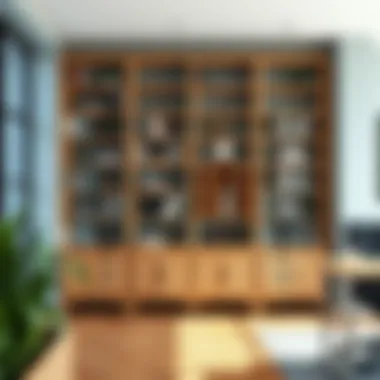
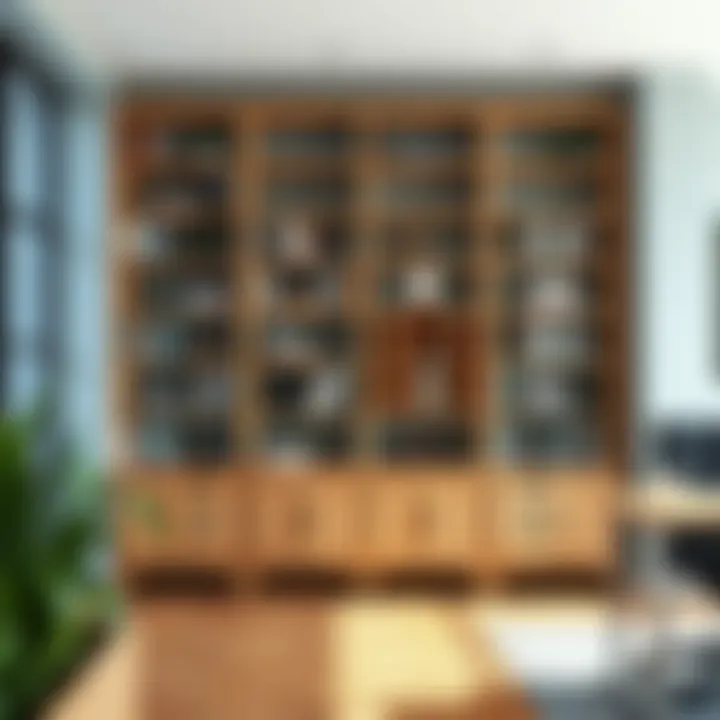
Creative Arrangements
Creative arrangements enhance the potential of bookshelf units beyond the ordinary. Mixing vertical and horizontal placements, utilizing different shelf heights, and adding stacks of books with decorative objects can result in an intriguing layout.
The key characteristic here lies in flexibility. Arranging books and decor can breathe life into a dull wall or corner, giving it character. This can also reflect personal style, transforming the bookshelf into a statement piece.
On the other hand, a disadvantage may arise if such arrangements are not thought through. Cluttered or chaotic displays may not only distract but could also create a misleading impression about the owner’s organization skills.
Utilizing Vertical Space
Utilizing vertical space in shelves is a clever way to maximize the overall storage capacity without occupying more floor area. Higher shelves are often ideal for storing items used less frequently, freeing up lower spaces for easy access.
The unique aspect of this method is its ability to make small rooms appear larger, ultimately optimizing the entire layout of a space. However, it's crucial to ensure that higher shelves are safely reachable, ideally with the help of aids such as stools or ladders designed for accessibility.
There’s a risk though; items placed too high can become inconvenient to access, potentially leading to neglect. Proper planning is essential for truly reaping the benefits of vertical shelving.
Multifunctional Uses
Home Offices
In a home office setting, bookshelf units serve as essential tools for organization, offering not just book storage, but spaces for work supplies and documents. The right design can provide a clutter-free environment that boosts productivity.
The key benefit here is efficiency. Well-organized shelves can significantly reduce the time taken to find essential documents or reference materials, streamlining workflow.
However, multiple functions can lead to unexpected clutter, depending on how one manages the items stored within. Keeping everything organized is, therefore, an ongoing challenge.
Living Rooms
In living rooms, bookshelf units can act as focal points, showcasing books alongside cherished decorations or family heirlooms. These units not only serve storage purposes but invite conversation and community.
The ability to combine items of different types in a cohesive theme is a significant advantage in living spaces. This approach can bring warmth and character to an otherwise standard room.
Despite this, keeping it balanced requires ongoing attention. Too many items can make the space feel cramped rather than welcoming.
Children's Areas
In children's areas, bookshelf units become more than storage solutions; they can inspire a love for reading and education. Colorful and thematic designs can engage children, encouraging them to interact with their books and learn.
The unique aspect is that these units can be tailored to suit different age groups, growing alongside a child’s interests and needs. This adaptability makes them a wise investment in a child's learning journey.
On the downside, children can create more clutter than adults, so regular organization and cleaning are vital to maintaining a tidy and appealing space.
"Bookshelf units offer a practical and aesthetic function, merging taste with utility across various settings."
Overall, the functionality of bookshelf units extends beyond simple storage. They adapt to different lifestyles, needs, and aesthetics, making them an invaluable part of any interior space.
Trends in Bookshelf Designs
Bookshelf designs, while serving a practical purpose, are increasingly becoming a statement of personal style and adaptability to modern living. The evolution of these units captures not just the essence of functionality but also reflects cultural shifts and design philosophies. Understanding current trends in bookshelf designs can help homeowners, designers, and DIY enthusiasts make informed choices that enhance their spaces. Incorporating these trends into your home can elevate the environment, making it both aesthetically pleasing and practical.
Minimalist Approaches
The minimalist approach to bookshelf design resonates deeply with the philosophy of simplicity. With an emphasis on clean lines, understated silhouettes, and a lack of ornate details, minimalist bookshelves allow for a sense of openness in any space. These units often feature materials like light wood or metal finishes, giving them a sleek, sophisticated look that doesn't distract from the beauty of the books or artifacts they hold.
- Benefits:
- Maximizes Space: Minimalist designs often take up less visual space, aiding in creating a more airy atmosphere.
- Focus on Functionality: Without unnecessary elaborations, these units can prioritize storage without taking away from design elements.
- Adaptability: They often blend seamlessly with other decor styles, making it easier to change the room's look without replacing existing furniture.
For those who thrive in a more open, clutter-free environment, these units present the perfect solution to organize and display literary collections without overwhelming the senses.
Sustainable Materials
In an age where environmental consciousness is key, sustainable materials are a game-changer in bookshelf production. Homeowners and designers alike are increasingly looking toward eco-friendly options, like reclaimed wood, bamboo, or recycled metals. These materials not only reduce the carbon footprint but also add character to bookshelf units.
- Considerations:
- Durability: Sustainable materials often boast longevity, reducing the need for replacements.
- Unique Aesthetic: Each piece of reclaimed wood or bamboo has its own story, bringing a unique touch and warmth to spaces.
- Reduced Waste: By choosing sustainable options, buyers support practices that minimize waste and promote responsible sourcing.
As a result, such bookshelves not only serve a practical purpose but also embody a commitment to sustainability, making them ideal for conscious consumers.
Smart Technologies
The integration of smart technologies in bookshelf designs is not just a trend; it's rapidly becoming an expectation. Modern homeowners seek more than just storage; they want multifunctional solutions that blend technology with design. Shelves equipped with LED lighting, built-in speakers, or wireless charging ports cater to today’s technological landscape.
- Benefits:
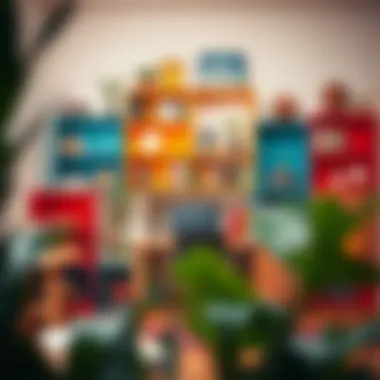
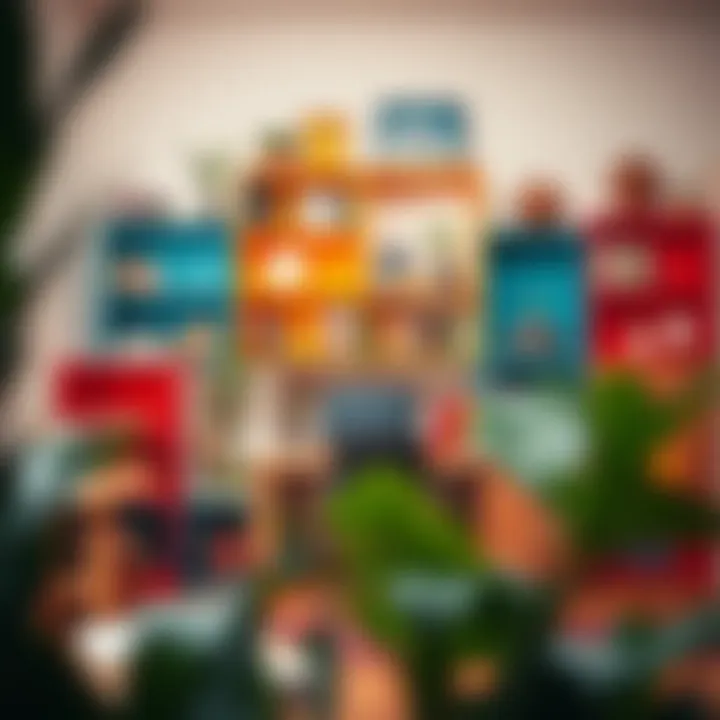
- Enhanced Functionality: Smart bookshelves serve multiple purposes, enriching the user experience.
- Aesthetic Appeal: These units can often look striking, combining technology with contemporary design elements.
- Connectivity: With smart features, one can seamlessly integrate bookshelves into a broader home automation system.
In a world where convenience and style are paramount, smart bookshelf designs cater to modern needs.
"Trends in bookshelf designs reflect a shift toward functionality and personal expression, seamlessly blending practicality with modern aesthetics."
By staying attuned to these trends, you'll not only keep your space stylish but also ensure it adapts to changing needs and preferences.
Selecting the Right Bookshelf Unit
Choosing the right bookshelf unit goes far beyond just finding a spot to stack your novels and coffee table books. It’s about creating an atmosphere that reflects your personality while serving practical needs. Whether you are a homeowner looking to enhance your living space, a designer crafting a unique environment, or a DIY enthusiast ready to get your hands dirty, understanding the nuances involved in selecting a bookshelf unit is crucial.
Bookshelves shouldn’t be a mere afterthought; their designs can elevate your interior decor, providing functionality without compromising style. Not only do they help organize books and collectibles, but they also function as statement pieces that can transform a room. Selecting the right unit involves assessing your specific needs, understanding your available space, and most importantly, considering your budget, which is where we’ll dive deeper into next.
Assessing Your Needs
When it comes down to choosing a bookshelf unit, the first step is examining your unique requirements. What exactly will you store? It could be a varied collection of hardcover classics, artful decor, or perhaps a mix of both. Knowing the purpose of the shelf will shape your decision.
- Type of Items: Consider the size and weight of the items. Oversized coffee table books need more robust shelves.
- Access Frequency: If you frequently need to grab books or items, opt for easy-to-reach designs.
- Display vs. Storage: Are you looking to display beautiful pieces with a casual arrangement, or do you need functional storage to hide clutter?
By ensuring that the unit aligns with your storage needs, you’re setting yourself up for success, keeping spaces organized and pleasing to the eye.
Understanding Your Space
Next, take a long hard look at your space; this is about more than just square footage, it’s about flow and function. A bookshelf can define a room's character, but it’s crucial to ensure it suits the available area.
- Measure the Area: From floor space to height, make sure to measure and keep track of your dimensions.
- Proximity of Other Furnishings: Consider how the shelf will interact with existing furniture. Will it block natural light or paths?
- Room Style: The bookshelf design should harmonize with the overall decor. A rustic wood bookshelf may look out of place in a sleek modern apartment.
Understanding all these elements allows you to visualize how a new bookshelf unit will coexist with your room, preventing a mismatch of styles and contributing to a cohesive environment.
Setting a Budget
Let’s face it: money talks, and establishing a realistic budget before you begin shopping can save you a lot of headaches down the line. Bookshelf units come in a wide range of prices, from budget-friendly options that won’t shake your wallet, to premium, handcrafted masterpieces.
- Prioritize Features: Decide whether you want specific features like adjustable shelves or built-in lighting. This can affect the overall cost significantly.
- Consider DIY: If you're inclined toward craftsmanship, building your bookshelf can save money while giving you the chance to customize it to your exact specifications.
- Quality Over Quantity: Sometimes, spending a little extra can get you a well-made piece that lasts years, as opposed to going for cheaper alternatives that might need replacing sooner.
Budgeting wisely helps you focus on options that not only meet your aesthetic requirements but also respect your wallet. With an understanding of your needs, the space constraints, and a practical budget set in stone, you’re now primed to make an informed choice and bring home a bookshelf that serves both form and function.
"A well-chosen bookshelf isn’t just furniture, it is a testament to personal style and organization."
Whether you're designing a cozy reading nook or a stylish office, remember to thoughtfully select a unit that resonates with your lifestyle.
Maintenance and Care
When considering bookshelf units, maintenance and care is an element that often slips to the back of one’s mind. Yet, it is critically important for both functionality and longevity. The way you treat these units can extend their lifetime and keep them looking their best, despite the everyday wear they may endure. A bookshelf should not just stand there gathering dust; it ought to enhance your space while fulfilling its purpose.
Cleaning Techniques
Let’s be honest, cleaning isn’t anyone’s favorite pastime, but it's essential. To keep your bookshelf unit shining like the diamond it is, regular cleaning is non-negotiable. Dust, dirt, and grime have a sneaky way of accumulating over time, altering not just the look but possibly affecting the materials.
Here are some tried-and-true cleaning techniques that you can employ:
- Microfiber Cloths: These are ideal for collecting dust without scratching surfaces. A dry cloth can often do the trick.
- Mild Detergents: For tougher stains, mix a few drops of mild soap in water, dampen a soft cloth, and gently wipe the shelves. Avoid soaking them, as too much moisture can warp wood.
- Vacuum Attachments: For those nooks and crannies, using a vacuum with a brush attachment can help reach where a cloth cannot.
- Glass Cleaner: If your bookshelf unit proudly displays glass shelves or panels, a glass cleaner will keep them crystal clear and smudge-free.
Managing Wear and Tear
Just like any hardworking piece of furniture, bookshelf units face the risk of wear and tear. Over time, these units can experience scratches, dents, and structural weaknesses, particularly if leveraged for storage and display. It’s vital to be proactive in managing these issues instead of waiting for them to escalate.
Here are a few practical strategies for maintaining your bookshelf’s integrity:
- Frequent Inspections: Every so often, take a moment to check for signs of damage. Look out for warped shelves, loose joints, or unexpected wobbling.
- Refinish Surfaces: If the finish starts to fade or gets damaged, consider refinishing wood surfaces. A bit of polish or a complete sand-and-stain can revive an aging bookshelf.
- Load Carefully: Be mindful of how much weight you place on the shelves. Exceeding weight limits can lead to sagging or breakage.
- Proper Placement: Ensure your bookshelf unit is on level ground to prevent any undue stress on its structure.
Taking the time to focus on cleaning and managing wear can significantly affect your bookshelf unit's aesthetic and functional qualities. After all, a well-maintained bookshelf isn’t just a piece of furniture; it’s a testament to your style and care.
Closure
The examination of bookshelf units extends beyond mere aesthetics, becoming a vital discussion for anyone interested in home decor or organizational solutions. Here, we summarize key insights derived from our previous sections while reflecting on the implications of these findings.
Summarizing Key Insights
Bookshelf units embody a duality of purpose: they merge functionality and design in ways that enhance any space. The following points encapsulate what we’ve explored:
- Diversity of Designs: From freestanding pieces to wall-mounted solutions, bookshelves can cater to different spatial requirements and personal tastes.
- Material Importance: The choice of materials—wood, metal, or glass—not only affects durability but shapes the aesthetic value of the unit within the overall room design. Each selection carries its weight in terms of maintenance and visual appeal.
- Organizational Versatility: Well-designed bookshelves facilitate not just the display of books but also the organization of various items. They can be adapted to fit home offices, children's play areas, or minimalist living rooms.
- Current Trends: Awareness of emerging design trends, such as sustainable materials and technology integration, informs choices that are relevant in today’s eco-conscious environment.
- Personal Functionality: Understanding one’s distinct needs—whether for storage or decoration—ensures that the bookshelf adds value rather than clutter.
Overall, the right bookshelf can serve as a focal point in a room, leading to not just practical benefits but also emotional and aesthetic satisfaction. With careful consideration, you can choose units that fit both your style and your needs.
Final Thoughts on Bookshelf Units
As we draw this exploration to a close, it’s evident that bookshelf units hold a unique position in our living spaces. They are not merely utilitarian structures; they reflect our personal journeys through the books we collect and the memories we cherish.
In this digital age, where physical books may seem to wane in importance, having a well-curated bookshelf can symbolize a commitment to knowledge and the tangible joys of reading. More than just furniture, these units invite conversation, foster creativity, and encourage exploration.
When selecting a bookshelf, consider not just the physical attributes, but also how it will resonate with your lifestyle and express your individuality. From classic designs to modern, minimalist approaches, there exists a wealth of options for every scenario. Ultimately, a thoughtful choice can transform a simple bookshelf into a statement piece, enhancing the function and style of your space.



